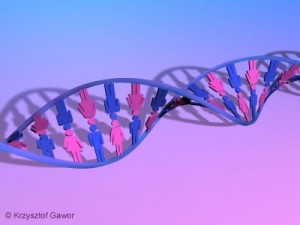 Carriers of A Common Gene Variation Startled More Dramatically in Response to Unpleasant Pictures
Carriers of A Common Gene Variation Startled More Dramatically in Response to Unpleasant Pictures
Washington—Inborn differences may help explain why trauma gives some people bad memories and others the nightmare of post-traumatic stress. Scientists in Germany and the United States have reported evidence linking genes to anxious behavior. The findings appear in the August issue of Behavioral Neuroscience, published by the American Psychological Association.
By showing that people who carry a common variation of a gene that regulates the neurotransmitter dopamine have an exaggerated “startle” reflex when viewing unpleasant pictures, the researchers offer a biochemical explanation for why some people find it harder to regulate emotional arousal. Their sensitivity may, in combination with other hereditary and environmental factors, make them more prone to anxiety disorders.
Researchers including Martin Reuter, PhD, of the University of Bonn, Germany, recruited 96 women averaging 22 years old from the Giessen Gene Brain Behavior Project, which investigates biomolecular causes of individual differences in behavior.
The researchers first determined which participants carried which variations (alleles) of the COMT gene, which encodes an enzyme that breaks down dopamine, weakening its signal. (COMT stands for a catabolic enzyme named catechol-O-methyltransferase.) Scientists call its two alleles Val158 and Met158. Depending on ethnicity, more or less half the population carries one copy of each. The rest of the population is roughly divided between carrying two copies of Val158 and two copies of Met158.
Using a well-validated psychophysiological measure, the researchers next measured the intensity of each participant’s startle response by attaching electrodes to the eye muscles that, upon emotional arousal, contract and cause a blink. Participants then viewed pictures that were emotionally pleasant (such as animals or babies), neutral (such as a power outlet or hairdryer), or aversive (such as weapons or injured victims at a crime scene)—12 pictures of each type for six seconds each. A loud, 35-millisecond white noise, called a startle probe, sounded at random while they watched. When participants blinked, showing the startle response, a bioamplifier took readings from the electrodes and sent the information to a computer for analysis.
People carrying two copies of the Met158 allele of the COMT gene showed a significantly stronger startle reflex in the unpleasant-picture condition than did carriers of either two copies of Val158 allele or one copy of each. The two-Met carriers also disclosed greater anxiety on a standard personality test.
This finding confirms that specific variations in the gene that regulates dopamine signaling may play a role in negative emotionality. The authors speculated that the Met158 allele may raise levels of circulating dopamine in the brain’s limbic system, a set of structures that support (among other things) memory, emotional arousal and attention. The researchers said that more dopamine in the prefrontal cortex could result in an “inflexible attentional focus” on unpleasant stimuli, meaning that Met158 carriers can’t tear themselves away from something that’s arousing—even if it’s bad.
The Met158 allele was created by a relatively recent mutation and only in the evolution of human beings. Other primate species such as chimpanzees carry only the Val/Val genotype. Co-author Christian Montag, Dipl. Psych., observes that for humans, wariness may have been adaptive. He points out, “It was an advantage to be more anxious in a dangerous environment.”
A single gene variation, says Montag, can explain only a small portion of variation in anxious behavior – otherwise, in theory, up to half the population could be anxious.
“This single gene variation is potentially only one of many factors influencing such a complex trait as anxiety,” he says. “Still, to identify the first candidates for genes associated with an anxiety-prone personality is a step in the right direction.”
Although a great deal more research is needed, Montag says that if this line of research bears fruit, one day “it might be possible to prescribe the right dose of the right drug, relative to genetic makeup, to treat anxiety disorders.”
Article: “COMT Genetic Variation Affects Fear Processing: Psychophysiological Evidence,” Christian Montag, Dipl. Psych., University of Bonn; Joshua W. Buckholtz, MS, Vanderbilt University; Peter Hartmann, PhD, University of Aarhus; Michael Merz, Dipl. Psych., Christian Burk, PhD, and Juergen Hennig, PhD, University of Giessen; and Martin Reuter, PhD, University of Bonn; Behavioral Neuroscience, Vol 122, No. 4.
(Full text of the article is available from the APA Public Affairs Office and at http://www.apa.org/journals/releases/bne1224901.pdf )
Martin Reuter can be reached via e-mail, or by phone at 0049-228-73-4399.
Source: The American Psychological Association (APA), in Washington, DC, is the largest scientific and professional organization representing psychology in the United States and is the world’s largest association of psychologists. APA’s membership includes more than 148,000 researchers, educators, clinicians, consultants and students. Through its divisions in 54 subfields of psychology and affiliations with 60 state, territorial and Canadian provincial associations, APA works to advance psychology as a science, as a profession and as a means of promoting human welfare.
